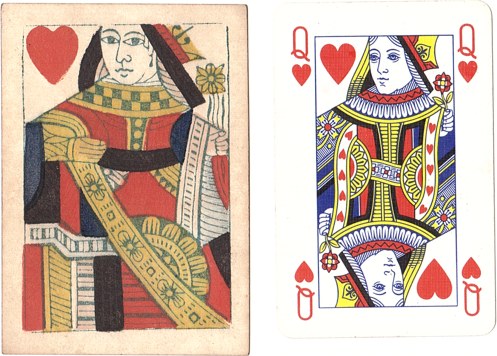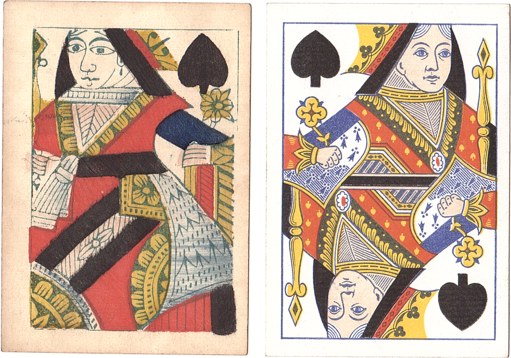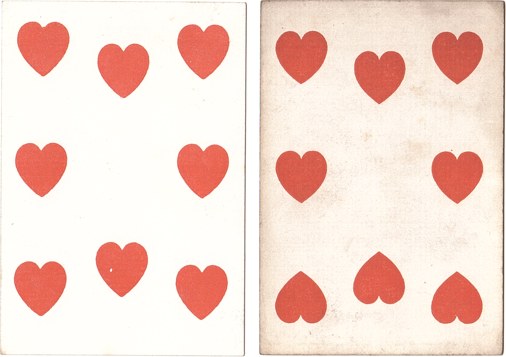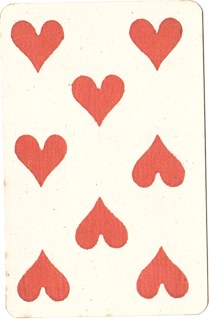OK, so here's a very brief overview of the history of playing card design.
The designs we in the English-speaking world today think of as standard originated in France. By the end of the fifteenth century, there were basically three standards: Latin (chalice, baton, coin, sword), Germanic (hearts, acorns, bells, leaves) and French (hearts, clubs, diamonds, spades). The actual look of the cards differed along cultural and tax jurisdiction lines, so you might have the same suits in Germany and Switzerland but some regional variety in how they appearanced; these different formats are called patterns. The English national pattern used the French suit system and basic court card design, with which it still shares some similarities (the Queen of Hearts stills holds a flower, that kind of thing); however, our cards derived from the Rouen pattern whereas France went the way of the Paris pattern, so the two diverged somewhat.
Patterns continued to evolve over time, but slowly and mainly as a result of the crude printing techniques of the day: two people trying to copy the same pattern when carving it into a wood block wouldn't come up with identical results. Furthermore, gamblers are superstitious and don't like changes because they bring bad luck; also, governments wanted all packs to look alike so they could be taxed effectively.
By the end of the eighteenth century, the English national pattern was well established. Here's a Queen of Hearts from my 1830 Reynolds deck alongside a modern version from a classic Waddington's Number 1:

Now although they're clearly the same basic thing, you'll notice some differences. The earlier pack is slightly bigger, has square corners, no index numbers and it features a full-length portrait. All playing card designs up until around the 1830s were full-length like this (the technical term is one-way). It wasn't just the court cards that were one-way: all the other cards were one-way, too. This means that the suit symbols (which, when arranged in a pattern to show what value the card has are called pips) were also all arranged the same way up.
Important but little-known fact: back then, people didn't hold cards like we do today, that is they didn't fan them out. If they had done so, they wouldn't have been able to tell what cards they were holding as they hadn't invented index numbers yet (there being very little point when most people, including those making the cards, couldn't read). Instead, they held them using two hands, a bit like a staircase:

Now you can see right away that there's a problem with this: you can't tell that the QH is the QH because it's upside-down. When people were dealt their cards the wrong-way up, they would therefore have to rotate their court cards to be the right-way up. This meant that other players could tell they were holding a court card. Printing technology was greatly improving in the 1830s, though, so manufacturers were able to experiment a bit. Two-way courts were introduced as a result. Because of the way people still held cards, though, they were reflected in the horizontal axis, not the lower-left to upper-right diagonal axis that would make more sense if cards were held like they are today.
This improved matters, but there was more to come. The next step was to move all the court card suit indicators to the top left-hand corner, because some were in the top right; having court cards two-way, this really showed. The affected cards were reflected in the vertical axis to standardise the position of the suit marker. Packs from before this happened are unturned; ones from after are turned. I don't possess an example of an unturned two-way pack, but here's my one-way Reynolds QS alongside one from my early-1860s De La Rue, so you see the principle:

At this stage, less than 100 years before I was born, pips were still one-way on the non-court cards. However, in the 1860s they went two-way too. This meant that whatever orientation you picked the cards up in, when you held them in your hand the actual part you looked at (at the top and down the left) was always the right-way up. Because of the earlier horizontal reflection employed in the court cards, people were seeing suit markers upside-down anyway when they looked at a card full-on, so this wasn't a big deal. Here's the 8H from the early-1860s De La Rue pack alongside one from my De La Rue deck circa 1865:

The next innovation was rounded corners (late 1860s), which stopped them from becoming creased (by cheats or by accident). A side-effect was that you could now fan your cards in one hand without their digging into your palm, which led to a change in the aspect ratio so that cards became narrower, too. This, plus the change in pip orientation and the general improved literacy of the population meant that the biggest change — corner indeces — could hit in the early 1870s.
So, the reason that we have pips reflected horizontally is essentially because until there were index numbers in the corners, people held their cards differently; to reflect them horizontally rather than diagonally made more sense. However, that's just how the (what's now known as) Anglo-American pattern went. In other countries, the change from one-way to two-way didn't necessarily come until later, just before index numbers were about to be invented and people were already holding their narrower cards in fans from the effects of rounded corners. Here's an example from a Paris pattern French deck I have dating from about 1870:

After that, the backs of cards got more decorative and people made the fronts more ornate, too. That's a whole other blog-post-when-I-should-have-been-working, though.